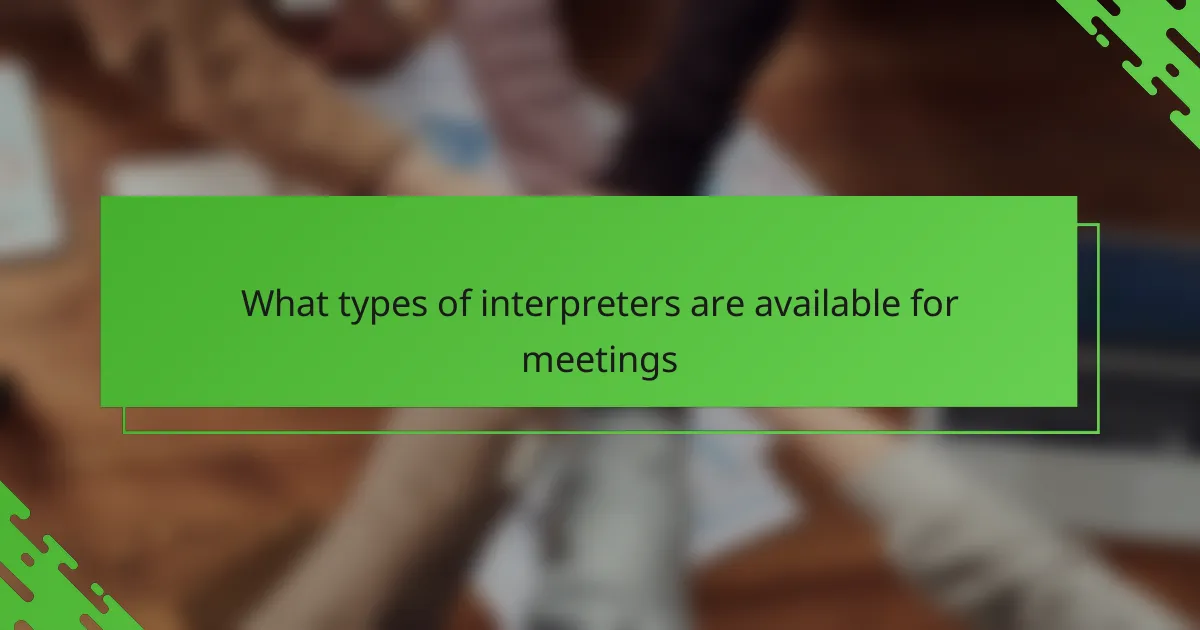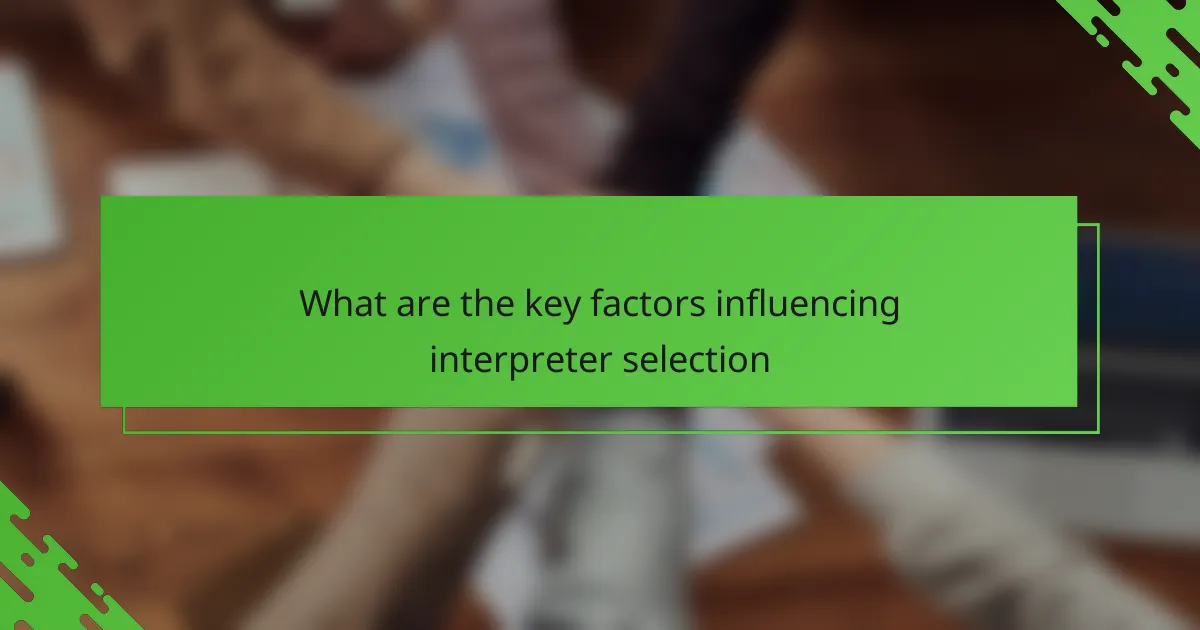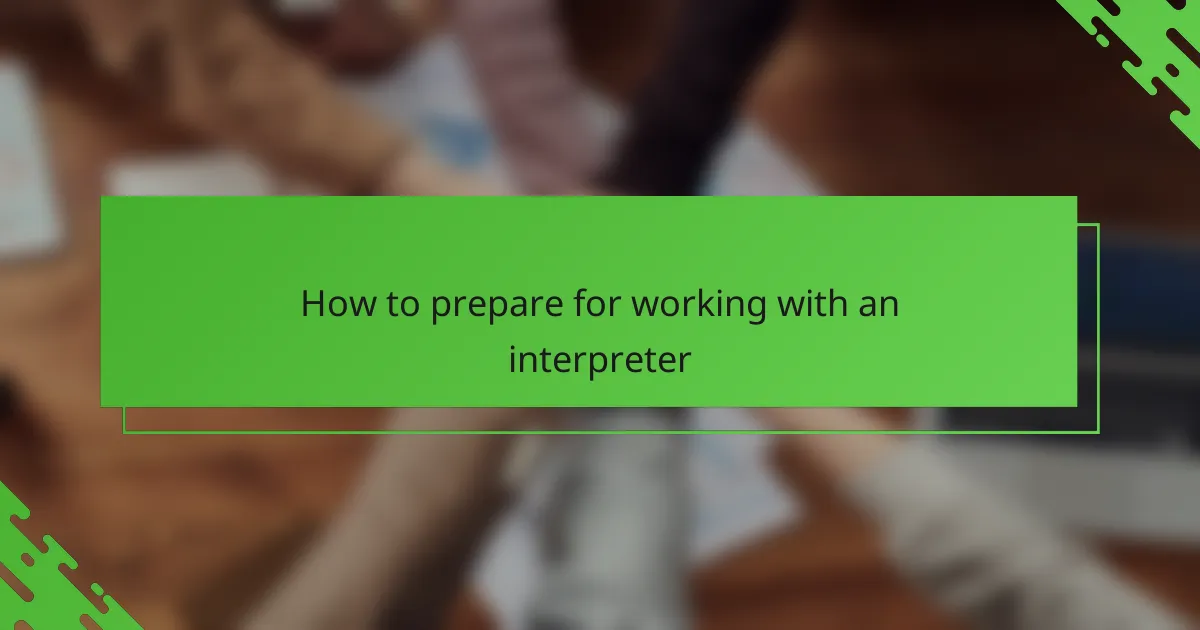Choosing the right professional interpreter for meetings is crucial for effective communication and understanding among participants. It requires careful consideration of their language proficiency, industry expertise, and cultural awareness to ensure that all voices are heard and respected. Understanding the different types of interpreters available, as well as the associated costs, can help you make an informed decision that meets your specific needs.

How to choose the right interpreter for meetings
Selecting the right interpreter for meetings involves assessing their language skills, industry knowledge, and cultural understanding. A well-chosen interpreter can facilitate effective communication and ensure that all participants are on the same page.
Assess language proficiency
Language proficiency is crucial when choosing an interpreter. Ensure they are fluent in both the source and target languages, with a strong grasp of idiomatic expressions and technical jargon relevant to your meeting.
Consider conducting a brief interview or test to evaluate their speaking and listening skills. Look for interpreters who can demonstrate their ability to convey complex ideas clearly and accurately.
Evaluate industry expertise
Industry expertise is essential for interpreters to understand the context of discussions. An interpreter familiar with your specific field—be it legal, medical, or technical—can provide more accurate translations and interpretations.
Ask potential interpreters about their experience in your industry. They should be able to discuss relevant terminology and concepts, which will enhance the quality of communication during the meeting.
Consider cultural knowledge
Cultural knowledge plays a significant role in interpretation. An interpreter should not only translate words but also convey cultural nuances that may affect communication.
Choose an interpreter who understands the cultural backgrounds of the participants. This understanding can prevent misunderstandings and foster a more collaborative atmosphere during discussions.
Review credentials and certifications
Credentials and certifications can indicate an interpreter’s level of professionalism and expertise. Look for interpreters who are certified by recognized organizations, such as the International Association of Conference Interpreters (AIIC) or similar bodies relevant to your region.
These certifications often require interpreters to meet specific standards and undergo rigorous training, ensuring they are well-prepared for professional assignments.
Check client testimonials
Client testimonials provide insight into an interpreter’s performance and reliability. Reach out to previous clients or check online reviews to gauge their satisfaction with the interpreter’s services.
Look for feedback that highlights the interpreter’s professionalism, punctuality, and ability to handle challenging situations. Positive testimonials can help you make a more informed decision when selecting an interpreter for your meeting.

What types of interpreters are available for meetings
There are several types of interpreters available for meetings, each suited to different formats and needs. The main types include simultaneous, consecutive, and remote interpreters, each with unique methods and considerations.
Simultaneous interpreters
Simultaneous interpreters translate spoken language in real-time, allowing participants to hear the interpretation almost instantly. This method is ideal for large conferences or events where multiple languages are spoken simultaneously.
When using simultaneous interpretation, it’s crucial to provide interpreters with the necessary equipment, such as headsets and microphones. This setup minimizes distractions and ensures clarity for both the interpreters and the audience.
Consecutive interpreters
Consecutive interpreters work by listening to a speaker and then interpreting the message after the speaker pauses. This method is often used in smaller meetings or one-on-one discussions, where the flow of conversation can accommodate pauses.
For effective consecutive interpretation, it’s helpful to have a notepad and pen available for the interpreter to jot down key points. This can enhance accuracy and ensure that important details are not missed during the interpretation process.
Remote interpreters
Remote interpreters provide interpretation services via video or audio conferencing platforms, making them accessible regardless of location. This option is increasingly popular due to its flexibility and cost-effectiveness, especially for virtual meetings.
When selecting remote interpreters, ensure that both the interpreter and participants have reliable internet connections and compatible technology. Testing the setup prior to the meeting can help avoid technical issues and ensure smooth communication.

What are the costs of hiring interpreters in major US cities
The costs of hiring interpreters in major US cities can vary significantly based on factors such as location, experience, and type of service required. Generally, you can expect to pay anywhere from a few hundred to several thousand dollars depending on these variables.
Hourly rates for interpreters
Hourly rates for interpreters typically range from $50 to $150 per hour in major US cities. Rates can be higher for specialized fields such as legal or medical interpreting, where expertise is crucial. It’s advisable to confirm rates upfront and inquire about minimum booking times.
Flat fees for events
For larger events, interpreters may charge flat fees that can range from $500 to over $2,500, depending on the event’s duration and complexity. This fee often includes preparation time and may cover multiple sessions throughout the day. Always clarify what the flat fee encompasses to avoid unexpected costs.
Travel expenses and accommodations
When hiring interpreters for events outside their home city, travel expenses and accommodations should be considered. These costs can include airfare, mileage, lodging, and meals, which may add several hundred dollars to the total bill. It’s best to discuss these details in advance to ensure all parties are aligned on expectations and budget.

What are the key factors influencing interpreter selection
Choosing the right interpreter for meetings hinges on several critical factors, including meeting size, duration, and technical requirements. Understanding these elements can help ensure effective communication and a smooth meeting experience.
Meeting size and format
The size and format of the meeting significantly influence the type of interpreter needed. For small meetings, a single interpreter may suffice, while larger conferences often require multiple interpreters working in teams to manage the flow of dialogue effectively.
Consider whether the meeting will be in-person, virtual, or hybrid. In-person meetings may benefit from interpreters who can engage directly with participants, while virtual meetings might require interpreters skilled in remote technology and platforms.
Duration of the meeting
The length of the meeting plays a crucial role in interpreter selection. For meetings lasting a few hours, a single interpreter may be adequate, but for longer sessions, it is advisable to have multiple interpreters to prevent fatigue and maintain accuracy.
As a guideline, interpreters typically work in 20 to 30-minute intervals, especially in high-stakes environments. Planning for breaks and shifts can enhance performance and ensure clarity throughout the meeting.
Technical requirements
Technical requirements encompass the tools and equipment necessary for effective interpretation. This includes audio-visual equipment, microphones, and interpretation booths for in-person events, or reliable software and internet connections for virtual meetings.
Ensure that interpreters are familiar with the technology being used. For example, if the meeting utilizes specific software for remote interpretation, confirm that the interpreters have experience with it to avoid technical disruptions.

How to prepare for working with an interpreter
Preparing for a meeting with an interpreter involves understanding the process and setting clear expectations. Effective communication with the interpreter before the meeting can significantly enhance the overall experience.
Understand the role of the interpreter
The interpreter’s primary role is to facilitate communication between parties who speak different languages. They do not provide personal opinions or add context; their job is to convey messages accurately and impartially.
It’s essential to recognize that interpreters may specialize in different fields, such as legal, medical, or technical. Choosing an interpreter with relevant expertise can improve the quality of communication.
Provide necessary materials in advance
Sharing relevant documents and materials with the interpreter ahead of time is crucial. This includes agendas, presentations, or any specific terminology that will be used during the meeting.
Providing these materials allows the interpreter to prepare adequately, ensuring they are familiar with the content and context, which can lead to smoother communication during the meeting.
Establish clear communication protocols
Before the meeting, discuss and agree on communication protocols with the interpreter. This includes how to signal for clarification, the preferred mode of interpretation (simultaneous or consecutive), and any specific preferences regarding pauses or interruptions.
Clear protocols help manage expectations and can prevent misunderstandings during the meeting, allowing for a more productive dialogue.
Consider the meeting environment
The physical setting of the meeting can impact the effectiveness of interpretation. Ensure the environment is conducive to clear communication, with minimal background noise and appropriate seating arrangements.
Using technology, such as microphones or video conferencing tools, can enhance clarity, especially in larger or remote meetings. Test these tools beforehand to avoid technical issues during the session.



